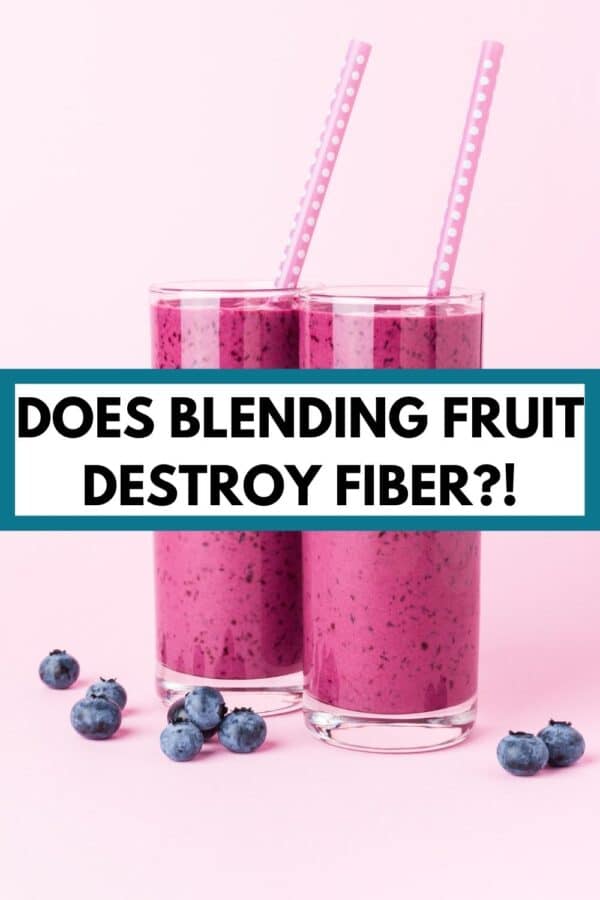Does blending destroy nutrients? Some folks claim blending blending fruits and veggies (like in a smoothie or blended soup) lowers fiber and other nutrients. But is it true? Honestly no, but you don’t have to take my word for it. As a registered dietitian, I’m going to share studies and scientific sources below, so if you like smoothies you can feel confident that they’re an asset to your health.
You may hear folks talk about macronutrients (or “macros”) — these provide energy (calories) to our bodies and consist of carbohydrates, protein, and fat.
On the other hand, micronutrients (vitamins and minerals) do not provide energy directly, but are essential in every bodily process (include metabolizing).
Also important to this conversation is fiber. Fiber is a type of carbohydrate, but unlike carbs that are broken down into digestible sugar molecules, fiber is unable to be digested. Because of this, it passes through your GI system intact (yes, this is why you may have seen corn kernels in your poop before).
Also no. Blended fruits and veggies are nutritionally comparable to their whole counterparts. So, if making a smoothie helps you get more produce into your day, then by all means continue doing so! That said, smoothies may be a little less satiating than their whole counterparts.

Does Blending Destroy Nutrients?
So, does blending destroy nutrients? In short, maybe a small amount, but nothing to be concerned over.
Typically when someone is saying that blending destroys nutrients, they’re usually trying to tell you that blending causes increased oxidation of fruits and veggies, which causes nutrient loss (think of cutting an apple and how the cut surface browns – this is enzymatic browning, a type of oxidation reaction).
While technically this is true, the nutrient loss is not dramatic. Let’s unpack it.
First of all, not all nutrients are antioxidants. So nutrient loss through oxidation is a non-issue with nutrients that aren’t antioxidants, like B vitamins and fiber (more on fiber later).
And for nutrients that are antioxidants, like vitamin C, vitamin E, copper, zinc, and selenium, nutrient loss through oxidation takes time (according to the Produce for Better Health Foundation).
Nutrient loss is inevitable with food. Per the University of California, Davis, the moment a fruit or vegetable is picked, nutrient loss starts. Add in the time it takes for the food to get from plant/ tree to your plate, and you’ve added a little more nutrient loss. Any sort of preparation, like cooking, peeling, chopping for a salad – it will all involve nutrient loss.
BUT!!! It’s all on a minor scale.
The net nutritional effect of drinking a smoothie is still positive.
In fact, one study found that consuming a 250-gram smoothie serving played a key role in helping different population groups achieve recommended daily nutrient intakes for vitamin C, minerals, and dietary fiber, minerals.
But let’s talk a bit more about fiber.

Does Blending Fruit Destroy Fiber?
Like mentioned above, fiber passes through your GI system intact. Which means it stands up to your teeth, molars, saliva, digestive enzymes, stomach acid, etc. And it remains unchanged.
So is a minute spin in a blender is going to destroy it?
Again, you don’t have to take my word for it because we do have some research that backs up fiber remaining in smoothies.
What happens to fiber if I cook or blend my veggies?
FAQ
Does blending break down nutrients?
Does blending help nutrient absorption?
Does blending food reduce calories?
Is blending food different than eating it?
Does blending increase nutrient loss?
Since oxidation occurs when fruits and vegetables are cut and exposed to oxygen, it’s thought that process of blending greatly increases oxidation and therefore greatly increases nutrient loss. But here’s the thing, oxidation takes time. Even if it takes you 15 to 20 minutes to gulp down that smoothie, nutrient losses via oxidation will be minimal.
Are you worried about losing nutritional value when blending fruits and vegetables?
If you’re worried about losing nutritional value, you don’t need to be. Many people jump on the fact that blending fruits and vegetables causes the nutrients found within to oxidize. Nutrients are lost when exposed to oxygen – this cannot be denied. However, it takes time for oxidation to have a real impact, about an hour after blending the fruit.
What happens if you blend food?
When you blend food, you introduce it to oxygen. Some claim that blending removes up to 92% of nutrients and fiber from fruit and vegetables. This claim is largely untrue. It takes 90 to 120 seconds of blending for oxidation to destroy 92% of nutrients and fiber. Most blenders are high-speed machines that produce juice in just 10 seconds.
Does blending destroy nutrients and fiber?
Many people who say that blending destroys nutrients and fiber are actually confusing blending with juicing. Blenders are used to make fruit juice, but they function very differently from juicers. A juicer will both destroy and remove nutrients and fiber.
